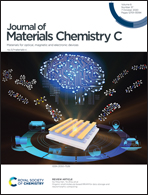A graphene–PDMS hybrid overcoating enhanced fiber plasmonic temperature sensor with high sensitivity and fast response
Abstract
A high-sensitivity and fast-response fiber-optic plasmonic temperature sensor is developed by coating graphene and polydimethylsiloxane (PDMS) onto an optical-fiber based plasmonic interface. The sensor is composed of a side-polished-fiber for light excitation and readout, a gold layer to excite surface plasmon resonance (SPR), graphene layers to enhance the SPR effect and accelerate the sensing response, and a PDMS layer acting as a thermo-optical responsive material. It is found that the number of graphene layers exhibits positive enhancement on the sensitivity toward the refractive index (RI) until 4 layers, and further increasing the number of layers leads to a decreased sensitivity. The four-layered graphene could improve the sensitivity of the RI sensor by 33% and the temperature sensitivity by 21.9% after overcoating the PDMS layer, increasing the temperature sensitivity from 1.28 nm °C−1 for the SPR sensor with a PDMS layer to only 1.56 nm °C−1 for the graphene–PDMS based sensor. Furthermore, the graphene layers shorten the response time of the temperature sensor by more than one order of magnitude, i.e., from 65 to 6 s. It is believed that the multilayer graphene/PDMS structure can be further exploited for optimizing other temperature sensors in terms of sensitivity and response time.



 Please wait while we load your content...
Please wait while we load your content...